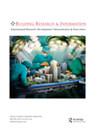Large-scale statistical analysis and modelling of real and regulatory total energy use in existing single-family houses in Flanders
IF 3.7
3区 工程技术
Q1 CONSTRUCTION & BUILDING TECHNOLOGY
引用次数: 6
Abstract
ABSTRACT Large-scale statistical studies on the gap between the real and regulatory energy use in residential buildings in Europe have shown that the regulatory calculation overestimated the real energy use, inflated true energy savings and undermined national energy policy making. Using data from 122,680 Flemish existing single-family houses, this research builds further on existing studies by contributing results for Flanders. The study also examines to what extent available aggregated variables explain the real annual total building energy use using statistical linear models and addresses the problem of multicollinearity and the importance of bootstrapped confidence intervals for model quality control. The overestimation of the real total energy use (and potential energy savings) by the Flemish regulatory method is exceedingly large compared to studies from other EU countries. The Flemish labels prove very poor indicators of the real energy use. Statistical linear models explain up to 46.6% of all variability and indicate that a significant extent of multicollinearity had to be corrected. Half of the variability has been left unexplained and has to be attributed to variables that were not available and the fact that the data were insufficiently accurate. Future analysis will explore whether more complex models identify more evidence.法兰德斯现有单户住宅实际和监管总能源使用的大规模统计分析和建模
对欧洲住宅建筑实际能耗与监管能耗差距的大规模统计研究表明,监管计算高估了实际能耗,夸大了真正的节能,破坏了国家能源政策的制定。本研究使用了122680栋佛兰德现有独户住宅的数据,通过为佛兰德提供结果,进一步建立在现有研究的基础上。该研究还检验了使用统计线性模型的可用聚合变量在多大程度上解释了实际的年度建筑总能耗,并解决了多重共线性问题和自举置信区间对模型质量控制的重要性。与其他欧盟国家的研究相比,佛兰德监管方法对实际总能源使用(和潜在的能源节约)的高估非常大。佛兰德的标签证明了实际能源使用的非常糟糕的指标。统计线性模型解释了高达46.6%的变异性,并表明多重共线性的显著程度必须加以纠正。一半的变异性无法解释,必须归因于无法获得的变量和数据不够准确的事实。未来的分析将探讨更复杂的模型是否能识别出更多的证据。
本文章由计算机程序翻译,如有差异,请以英文原文为准。
求助全文
约1分钟内获得全文
求助全文
来源期刊

Building Research and Information
工程技术-结构与建筑技术
CiteScore
8.60
自引率
7.70%
发文量
43
审稿时长
>12 weeks
期刊介绍:
BUILDING RESEARCH & INFORMATION (BRI) is a leading international refereed journal focussed on buildings and their supporting systems. Unique to BRI is a focus on a holistic, transdisciplinary approach to buildings and the complexity of issues involving the built environment with other systems over the course of their life: planning, briefing, design, construction, occupation and use, property exchange and evaluation, maintenance, alteration and end of life. Published articles provide conceptual and evidence-based approaches which reflect the complexity and linkages between cultural, environmental, economic, social, organisational, quality of life, health, well-being, design and engineering of the built environment.
 求助内容:
求助内容: 应助结果提醒方式:
应助结果提醒方式:


